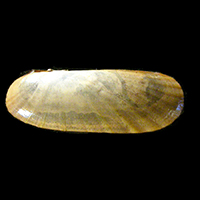|
< Previous family introduction |
|
|||||
 |
Family Solemyidae
|
|||||
|
The Solemyidae is a family of chemosymbiotic bivalves. Members maintain bacteria in the gills that produce energy by oxidising sulphur compounds obtained from the environment. They live in shallow muddy environments such as seagrass beds along with other chemosynthetic bivalves including the lucinid Pillucina vietnamica. The very thin shells are unusual in that they are almost cylindrical, gape at both ends, and are covered with a periostracum that extends beyond the margin of the shell. The best known species of the family in Australia is Solemya australis, which occurs in southern Australia but does not extend into NSW. (Lamprell & Healy (1998) reported, in error, that this extends as far north as southern Queensland). It is a large species reaching 50 mm in length. Only one species – Solemya velesiana – occurs in NSW. This is much smaller than S. australis, reaching only 16 mm in length. The habitat of Solemya velesiana in NSW has not been reported, but in southern Queensland it lives in seagrass beds, burrowing in the substrate. Family Reference Taylor, J.D., Glover, E.A. & Williams, S.T. 2008. Ancient chemosynthetic bivalves: systematics of Solemyidae from eastern and southern Australia (Mollusca: Bivalvia). Memoirs of the Queensland Museum – Nature 54(1): 75-104. Coverage The only member of the family known in NSW is detailed here. Identification Notes Shells are placed in the family by being almost cylindrical with a periostracum that extends beyond the shell’s margin.
|